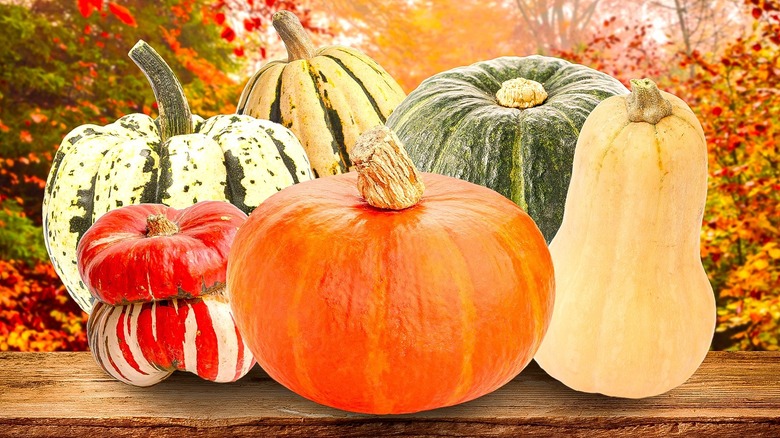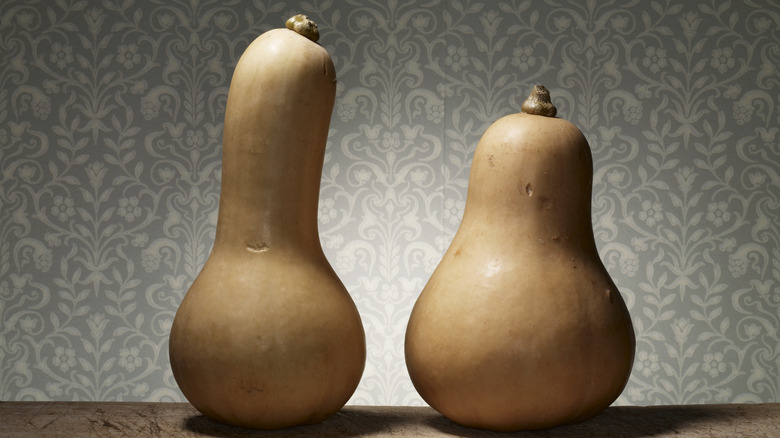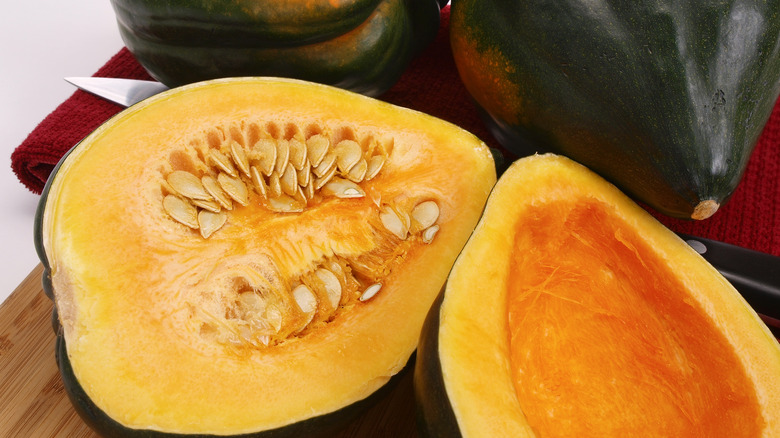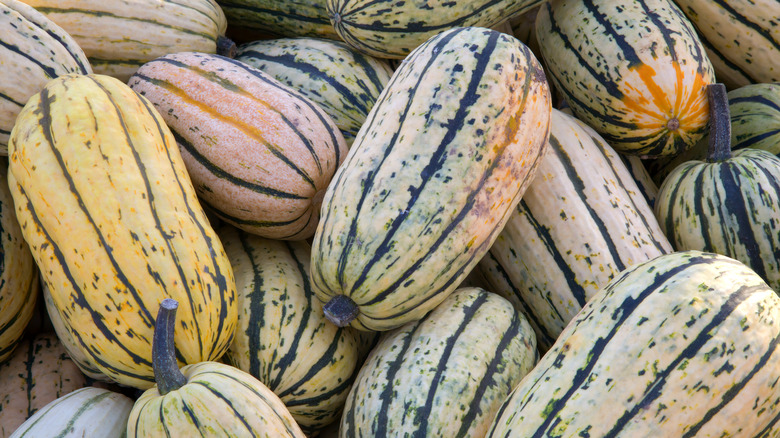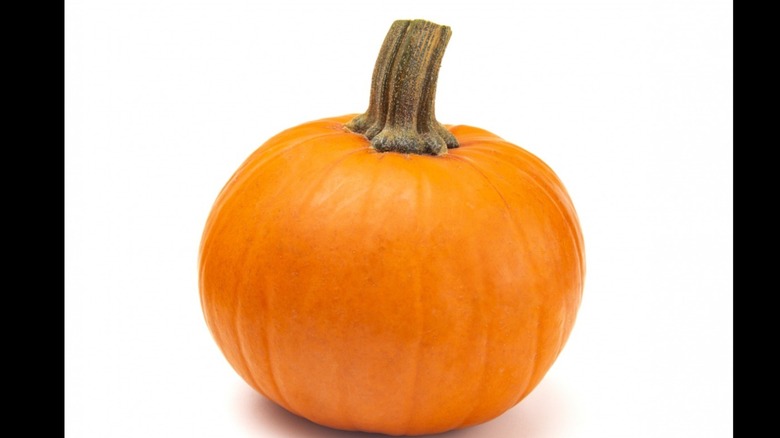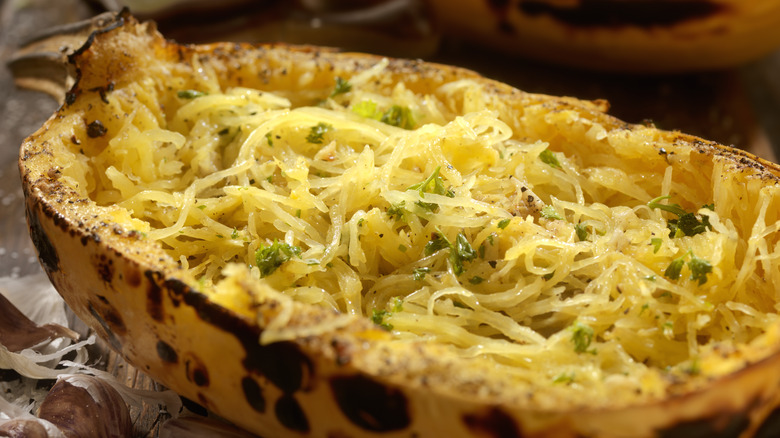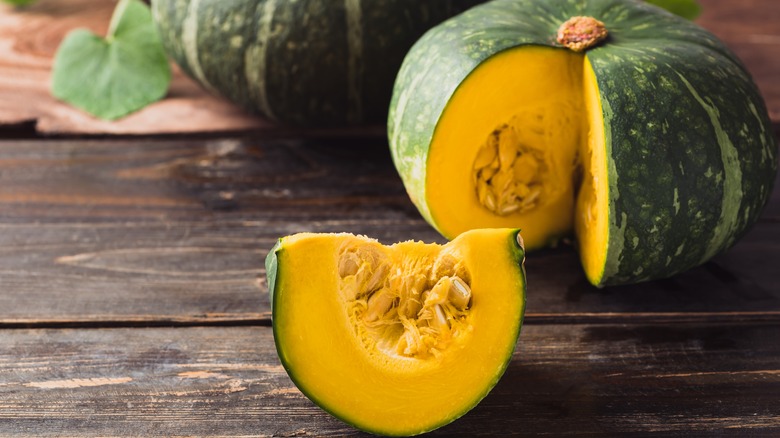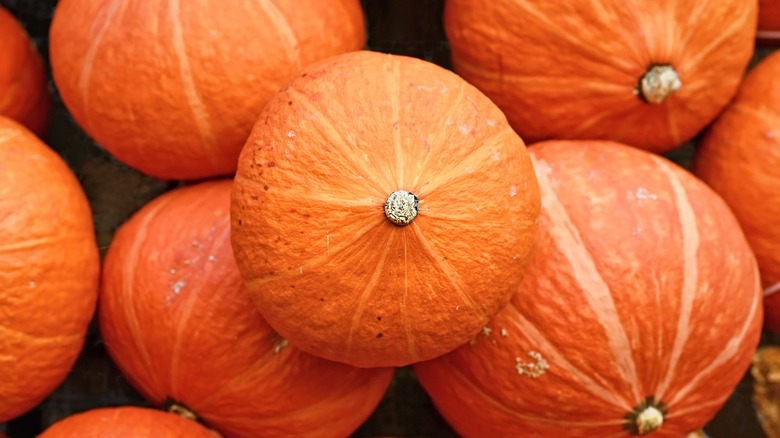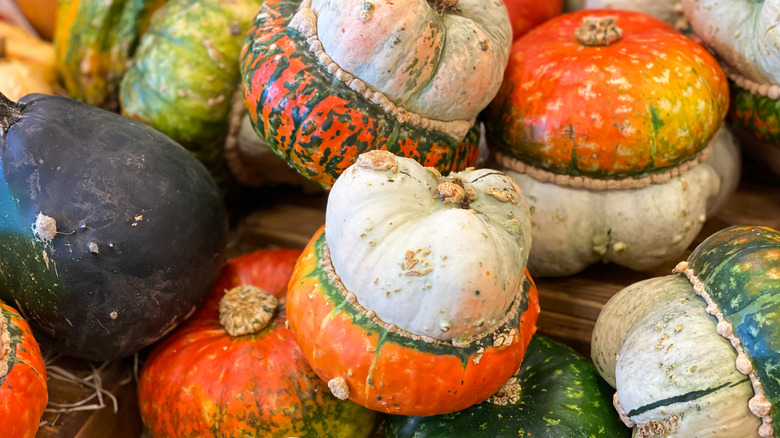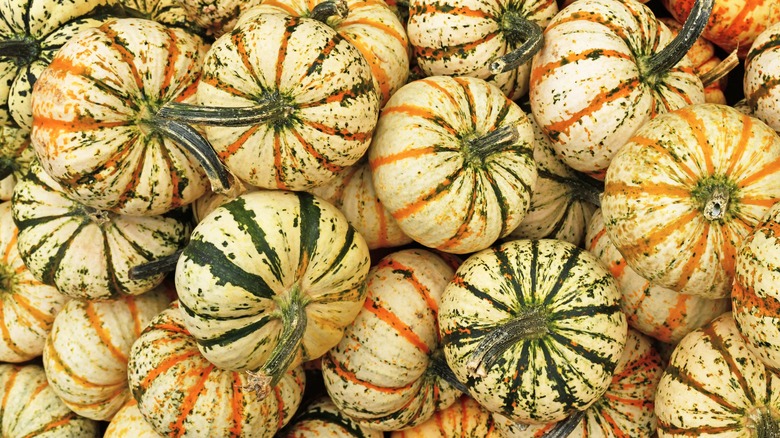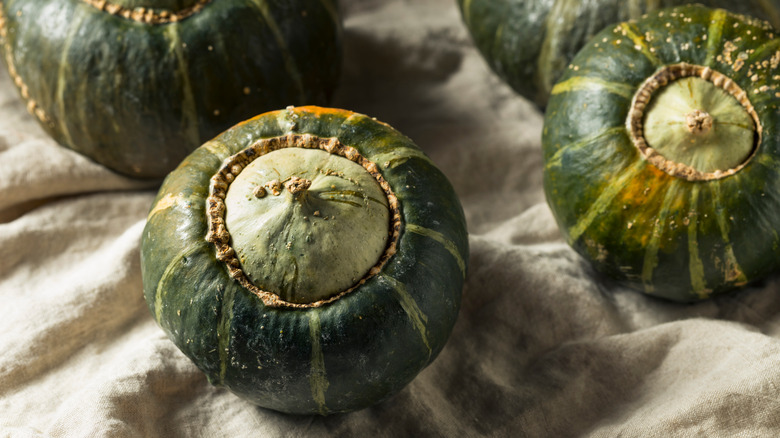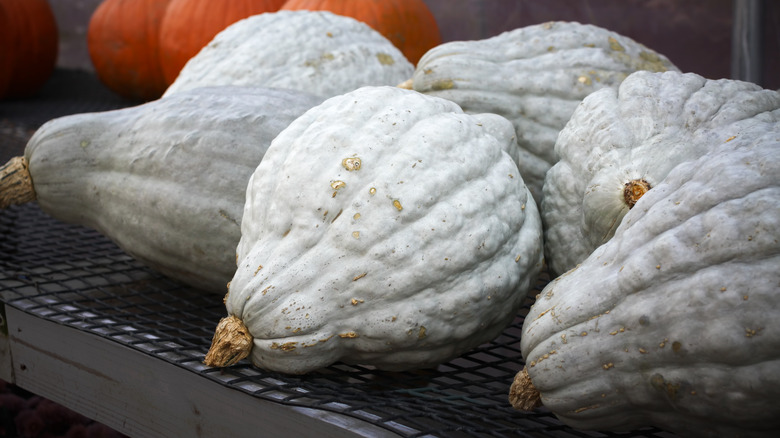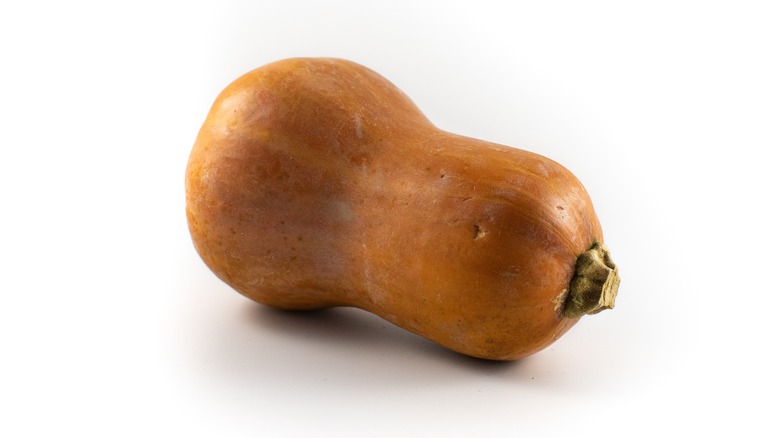12 Types Of Pumpkin And Other Squash To Cook This Fall
When the days get shorter and the long nights get colder, nothing soothes the soul, fills the belly, and eases the strain on the wallet better than winter squash. Pound for pound, winter squash packs a ton of nutrition, making it a no-brainer to round out soups, stews, and salads.
Pumpkin and other squash stores well, too, which means that home gardeners confronted with rows of vegetables in the family Cucurbitaceae can rest easy knowing their crop will last throughout the colder months.
If the only recipe for pumpkin and winter squash you're familiar with is pie, get ready to expand your horizons. There is a whole world of culinary delights awaiting you and plenty of squash to bring along for the ride. Winter squash is easy, versatile, and tasty — the perfect ingredient for both fast weeknight meals and long, slow Sunday braises. Whether you've never experimented with squash and your family is squash-averse, or you're open to experimenting with something new, we've got you covered.
1. Butternut squash
Butternut squash is an entry-level squash with a sweet flavor similar to a sweet potato. Because the roasted or baked textures of butternut squash and sweet potato are similar, these two vegetables can be used interchangeably.
Look for a smooth, bell-shaped squash with tan skin. The inside of the squash has orange flesh, with seeds bunched into the larger end of the squash. Butternut can be roasted, puréed, or added to soups. Some cooks use the squash as a vessel and add stuffing to it, while others dice it into small cubes and add to a creamy risotto studded with black pepper and finished with a touch of butter.
Some preparations of butternut squash — in a purée or a risotto, for example — require you to peel the squash before proceeding. Peeling is best done on a cutting board using a y-peeler. Hold the squash firmly in one hand and peel away from you.
One of the most delicious ways to enjoy butternut squash is baked with spicy fall flavors. This requires you to peel the squash, but you have options if you'd prefer to skip that step. Cut your butternut in half lengthwise for no-peel prep, and scoop out the seeds. Preheat your oven to 400 F and line a baking sheet with parchment paper. Add a little bit of olive oil to the cut surface of the squash, and place face down on the roasting pan until the squash is tender (about 45 minutes).
2. Acorn squash
Acorn squash is named for its minor resemblance to actual acorns. The skin of the squash is dark green, sometimes with a splatter of orange or yellow, and it features prominent ridges, almost like a pumpkin. White acorn squash is also available and is an excellent mashed potato substitute.
The most popular method of preparation for acorn squash is roasting. Roasting with just a little butter or olive oil is delicious. Season with salt and pepper and scoop the delicate flesh right from the bowl of the squash itself.
To make roasted squash more of a main course, stuff it. Omnivores might enjoy acorn squash stuffed with sage and sausage, while vegetarians and vegans will be perfectly content with quinoa and mushroom-based stuffing. To prepare, slice your acorn squash lengthwise in half and scoop out the seeds. Add just a little olive oil to the surface of the squash, and roast, cut side up, for about 40 minutes at 400 F.
While the squash bakes, prepare your favorite hearty stuffing. Load up the roasted squash. At this point, Depending on your filling, you can sprinkle the tops with a little bit of parmesan cheese and return it to the oven to warm and develop across. Or you can simply serve the stuffed squashed with the warmed filling as is.
3. Delicata squash
New cooks looking for an uncomplicated, novice-level squash to experiment with this fall should look no further than delicata. Delicata squash is easily recognizable in that it's one of the few on the list that is a long cylinder. The skin is yellow or cream-colored, sometimes with a bit of orange. Its trademark green stripes and slight ridges set it apart, too.
But one of the best parts of this abundant, delicious squash is that the skin is edible. It's thin enough so that peeling isn't necessary, and the yellow flesh is delicious steamed, braised, roasted, or fried. There is an almost infinite number of recipe variations for roasted squash.
To roast delicata squash, preheat your oven to 450 F. Cut off both ends of the squash, then cut it carefully lengthwise between one of the ridges. Insert the knife about ¼ inch, then use the flat of your hand to pound the knife into the squash, rocking back and forth once the top of the blade is no longer visible.
Use a spoon to scoop out the seeds. Flip the squash to the flat side and slice crescents of about ½ inch. Add to a bowl, and add a little olive oil, salt, and pepper. Toss to coat thoroughly, then place on a baking pan and roast for 12-18 minutes or until the squash is tender and slightly caramelized, flipping halfway through the baking time.
4. Sugar pie pumpkin
Yes, when time is tight and you're on a schedule, choosing a canned pumpkin for all your baked goods works just fine. Its quality is consistent, and it's easy to use.
However, when sugar pie pumpkins hit the store, consider snapping up a few to add to your baking pantry. These smaller winter squash are less fibrous, with an interior that turns creamy when it's cooked. Its flesh is deliciously sweet, perfect for pumpkin pie and other baked goods, but the flavor can also balance savory dishes.
When selecting a sugar pie pumpkin, look for smaller squash with ridges that are not as defined as their jack-o'-lantern counterparts. They should feel heavy and have dull skin. Turn the pumpkin over in your hands to look for bruises, cracks, or damage to the stem area. This indicates a pumpkin that may be past its prime.
Bake or roast your pie pumpkin to caramelize the flesh and deepen the flavor before scooping it out to purée for pie. You can also peel, chop, and boil the pumpkin (or bake it in smaller chunks to speed up the process).
5. Spaghetti squash
Spaghetti squash is another cylindrical winter squash with a unique interior. The skin, which ranges from bright yellow to the palest lemon, hides a stringy, watery texture that resembles spaghetti when shredded with a fork.
There are some important steps to preparing this watery weirdo. On their first cooking attempt, inexperienced cooks often end up with a dripping plate of stringy fibers coated in watery tomato sauce. This dish might put them off preparing this vegetable in the future. To properly prepare spaghetti squash, cut the ends off before slicing it in half crosswise. Cross-cutting the squash and removing the ends allows excess moisture to escape, so you can avoid excessive water.
Once you've cut your squash in half and removed the seeds, roast it cut-side down in a 400 F oven for about 40 minutes. Once it's cool enough to handle, use a fork to gently separate the strands of squash before proceeding with your recipe. You can top it with your favorite tomato sauce, sauté it with butter, garlic, and red pepper flakes, and even bake it into a lasagna.
6. Kabocha squash
Kabocha squash is also known as a Japanese green pumpkin, and it is easy to see why. The outside of this winter squash is dull, with dark green skin and a bumpy texture, and its shape is that of a small, squatty pumpkin. Although there are red and orange varieties, dark green is the most common. Inside, the flesh is bright yellow-orange, and the seeds are small. Due to its edible skin, many preparations of this squash don't require peeling — a bonus.
The taste of kabocha is a lot like a sweet potato. The texture is bright, light, and fluffy, all qualities that make this squash perfect for mashes and purées. The intense sweetness of kabocha also means that it plays well with spicy, sour, and pungent flavors. Add kabocha to a hearty seasonal stew, or make it the star of the show in a warming kabocha squash curry.
Another way to enjoy kabocha is to roast it with the skin on and serve it as a side dish. You can also roast the squash, chill it, and add it to a hearty seasonal salad with winter grains such as farro or barley. Don't forget to sprinkle with chopped fresh herbs to brighten the dish.
7. Red Kuri squash
You may not be familiar with the Red Kuri squash, with its bright orange flesh and teardrop shape. Red Kuri is sometimes referred to as an orange Hokkaido pumpkin.
"Kuri" means chestnut in Japanese, which fits this squash's flavor profile. The skin is edible after cooking, and the smooth interior flesh is yellow with a mild chestnut flavor.
When buying Red Kuri squash, look for a vegetable that is heavy for its size. It should have no soft spots or dents, and the skin should be firm and intact. Cook and enjoy this squash much as you would an acorn squash. It's perfect for stuffing and roasting and is also delicious in soups, imparting a nutty flavor.
As with other long-storing varieties (butternut among them), Red Kuri can stay fresh for up to six months when stored in a cold, dry spot in your kitchen. You can also cook and freeze the cooked flesh to store it even longer.
8. Turban squash
If you judge a squash by its looks, you might walk right by this one. Turban squash is the unsung, somewhat unsightly hero of the squash family. Most people use this funny-looking vegetable as fall decoration only, but it's a delicious selection when you're looking for flavorful winter squash.
The shape of a turban squash is distinct, and the coloring is vibrant in hues of green, dark red, yellow, and orange. The skin has tan bumps and stripes, and the squash is short and compact. Inside, the flesh is starchy, a little sweet, and slightly nutty in flavor. Regardless of color, size, and shape, all turban squash is considered an heirloom squash. This means that they have all been naturally pollinated for at least 50 years.
The skin of the turban squash means that prep can be difficult. If you will be puréeing the final product, take the easy route and roast your squash whole. Poke holes in the skin to allow steam to escape, and roast slowly at 300 F for 2-3 hours or until the flesh is soft (a great project on a wintry day). You can also treat it like an acorn or Butternut squash, slicing it in half, removing the seeds, and roasting it cut side down until soft.
If you do choose turban squash for soup, it's easier to remove the skin if you roast it slightly first. Then peel the squash, dice it into cubes, and proceed with your favorite recipe.
9. Carnival squash
If it's a party you're after, carnival squash should be invited. This festive miniature squash is a cross between an acorn and a dumpling squash. The result? A squat squash that resembles a flattened pumpkin with deep grooves. It has a dramatic color scheme — it's light tan with orange stripes running stem to ground end and splashes of green, yellow, and orange. Because it's so festive, carnival squash is often used to decorate the holiday home'
But if you just leave it on your mantle, you'll miss this squash's complex, delicious flavor. The flesh is nutty and sweet, with hints of holiday baking spices, pecans, and maple syrup. You could make a simple, flavorful mash, but sautéing, roasting, and boiling are also common methods of preparation. The skin of carnival squash is thin and edible, so slicing the fruit raw and adding it to salads or a platter of crudites is also an option.
The most dramatic way to prepare carnival squash for a special occasion is to roast it whole and stuff it. Squash can be cleaned like a jack-o'-lantern, slicing off the top and scooping out the seeds to create a perfect bowl for stuffing. Roast the empty bowl until it is soft, then fill with the stuffing of your choice. The earthiness of turmeric is an especially good match for this sweet squash.
10. Buttercup squash
Buttercup squash has a sweet name and an even sweeter application: Like sugar pie pumpkin and Hubbard, buttercup is an excellent squash to make pumpkin pie with. It's another squatty, unassuming squash, with dull, dark green skin and an orange dot on the bottom. Substitute buttercup in any recipe that calls for acorn squash — it has a similar flavor profile and fleshy texture.
This squash is best roasted whole or even steamed. The skin is very tough and challenging to peel, so skip that step and roast as you would (cut in half, cut side down, in a 400 F oven until soft). It can also be stuffed once it's roasting or scooped out and mashed.
If you have your heart set on soup or another dish that requires diced squash, roast your buttercup for about 10 minutes before removing it from the oven, peeling it, and dicing it to the size you need.
11. Hubbard squash
Eating with your eyes has been tough on Hubbard squash's public relations. They can grow up to 49 pounds, every inch of which is covered with a thick, bumpy, grey-blue skin that is bumpy and tough. Even the average Hubbard — around 15 pounds — is about a foot in length. There are also orange Hubbard squash, which are sweeter and smaller than the blue Hubbard.
Inside, things don't look much better. The yellow-orange flesh of this squash can be grainy and somewhat dry. This isn't a great advertisement for this squash — it's also difficult to peel. But once prepped, you'll have a winter vegetable that is sweet and flavorful, with lots of nutrients to counteract the colder days of fall and winter.
One of the best preparation methods for Hubbard squash is Alex Sigeti's spiced creamy bisque. This recipe uses thyme, cognac, and warming baking species to create the coup's lush body before tipping it with a nutmeg-scented crème fraîche for serving.
12. Honeynut squash
Honeynut squash is butternut's baby sibling. It's a petite, single-serving squash with deeply flavorful flesh that marries down-home dinners with fine dining. Honeynut squash was created when Chef Dan Barber of Blue Hill at Stone Barns asked vegetable breeder Michael Mazourek to create a sweeter squash. The result is a sweet winter squash at home in both fancy kitchens and farmhouse tables.
The outside of honeynut squash is a slightly darker version of butternut. Inside, you'll find flesh with a similar hue but even sweeter than the larger butternut. Unlike butternut, honeynut squash has thin, edible skin that need not be peeled before cooking.
Honeynut shines with minimal additions (the entire point of the squash), roasted and seasoned with a bit of butter, salt, and pepper to highlight its sweetness. It can also be stuffed, steamed, pureed, and added to soups and risotto. Take care not to overwhelm the flavor with too many other ingredients. While not delicate, the sweetness can be overshadowed if a deft seasoning hand is not used.
